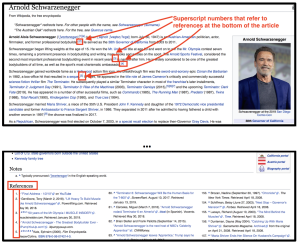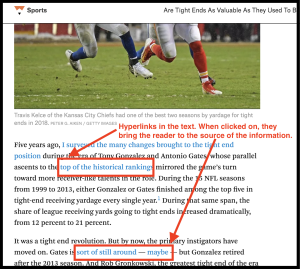24
Key Concepts
- Web-based genres (websites, blogs, etc.) tend to use different citation methods than what’s typically used for a project in a class (e.g. APA, MLA, etc.)
- Attribution–giving credit to the original source when we borrow information–remains necessary in web-based genres
- When composing in web-based genres it remains necessary to be consistent with how we’re giving attribution for borrowed information
- It remains necessary to follow the genre conventions for attribution in the given web genre we’re composing in.
As mentioned in Chapters I and IV of this book, writing involves an ethical dimension, and an important aspect to considering the ethical dimensions of writing involves following proper attribution protocol when we’re borrowing information from elsewhere. Equally, while we might be familiar with one or two particular citation methods–like APA, MLA, or Chicago–it’s useful to note that the way we’re citing information is dependent on our audience’s expectations and what’s appropriate for the genre we’re writing in. On some level, we’re all already aware of this, since some classes require us to cite things in MLA, while others require APA or Chicago or something else.
Following a set of attribution protocol for any given writing project, then, requires us to understand what the appropriate citation conventions are for the genre we’re working in. Oftentimes, when we’re writing something for a class we’re in, the genre we’re writing in is “College Essay,” or, more accurately, it’s probably a sub-genre of the larger genre of “College Essay”–say “Research Paper,” “Literature Review,” “Lab Report,” etc. And depending on the subject that the class is in, we would typically use a method of citation common to a class in that discipline.

While the way that we attribute borrowed information changes depending on the genre we’re working in or the rhetorical situation itself, what’s important to keep in mind is that we must always attribute any borrowed information to the original author–this includes things that are directly quoted as well as those that are paraphrased. Equally, it includes text as well as multimodal information (like images or videos).

While we might have a lot of experience using a citation method like APA or MLA, we may find ourselves increasingly working in online genres–like websites or blogs for example. As we’re likely aware, when we’re reading something online–like a piece of online journalism or a Wikipedia article–we typically won’t see things cited in the manner we use in our classes, which, depending on the citation method we’re using, often involves an in-text citation that refers the reader to a references section at the end of the work. Equally, not all websites cite things in the same way. For example, Wikipedia (see example) uses endnotes–superscript numbers that point the reader to a citation for a reference at the bottom of the article– while some sources of online journalism (see example) link out to the sources they’re referencing by attaching those sources as hyperlinks that are connected to words in the text.
Recapping the Main Ideas Behind Attribution on the Web
Anytime we’re citing things online, we must:
- Give full credit to the original source, as we would anytime we are citing anything in any format
- Follow the appropriate conventions for the genre and the rhetorical situation.
- Be consistent about how we’re citing things
